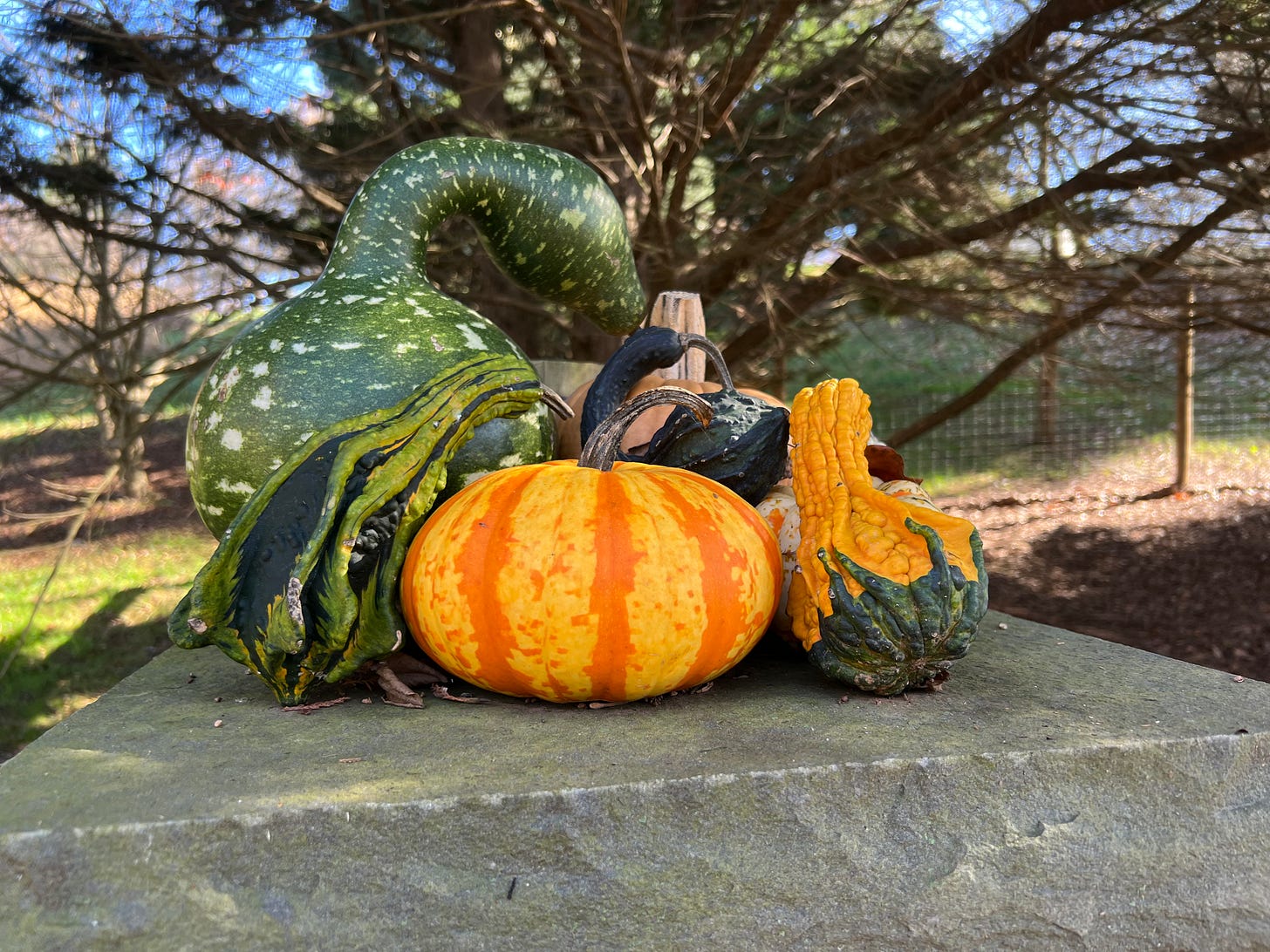Smashing Pumpkins
Puddock Hill Journal #30: The trash is the last place you want to throw a pumpkin.
With Halloween in the rearview mirror and cooler temperatures finally threatening to settle in next week, one’s mind turns to the sorry remains of our decorative pumpkins.
As our house is not visible from the road, we don’t put on a big pumpkin and gourd show, but the women who refresh our planters every season (shout-out to Prairie Wind) compose seasonal displays atop our gate pillars. I referred to these above as “sorry remains,” but in fact they have weathered well so far, I suspect because we have yet to experience a hard frost. Here’s what they look like today (black walnut fruit added by nature):
Lovely and whimsical, but soon they will indeed start to show their age.
We have long disposed of our pumpkins at the edge of any nearby woods, but a recent NPR article reminded me that many folks might still be putting theirs in the household trash.
As the article notes, pumpkins, like any plant material that ends up buried in a landfill, will undergo anaerobic decomposition, which produces methane gas. If, as is most likely, your local landfill does not capture the methane, it eventually escapes into the atmosphere, where it acts as a greenhouse gas that is eighty times more potent than carbon dioxide until breaking down in twenty years. Needless to say, this does not represent a preferred outcome for anyone who gardens (or lives on Earth).
Any one family’s pumpkins may seem inconsequential in this big world, but consider that of more than 2 billion pumpkins grown in the United States each year, only twenty percent go for food. The rest are decorative. Why not put those otherwise wasted calories to productive use?
If you compost your garden waste, the easiest thing to do is smash the pumpkin and toss it into the pile. If you are cultivating wild edges on your property, as we do at Puddock Hill, a good backyard stewardship practice is simply to chuck the pumpkins in that area. When we have done this in the past, they disappear in no time.
We don’t smash our pumpkins. Instead, we let nature do with them as it will. The first ones at the feast will likely be groundhogs, mice, and raccoons. After that, it’s birds and deer. Then, perhaps, microbes. A word of caution: To keep critters and deer at a comfortable distance, do not dispose of your pumpkins too close to the house!
The NPR article suggests “removing wax, paint or marker” from the pumpkin before putting it out for wildlife. I agree on the paint or marker, but removing wax strikes me as unnecessarily fussy. Pumpkins, like many fruits, naturally produce their own protective wax, and any wax added by suppliers of edible fruits and vegetable must be food grade. We eat this wax all the time when we consume cucumbers, apples, peppers and such. If it doesn’t hurt us, I doubt it will hurt wildlife.
If you don’t have wild edges on your property or a wild place nearby where you can discretely toss your pumpkins, donate them to a wonderful organization called Pumpkins for Pigs. Their mission (you guessed it) “is to match pigs (and other pumpkin-eating animals) with un-carved, non-inked/non-painted pumpkins to prevent them from being thrown in the landfill.” Your pumpkin will go on to feed farm animals and those living in sanctuaries. Pumpkins for Pigs has a surprisingly large number of drop-off locations with a convenient map on their website. Alternatively, if you know a farmer, you can possibly cut out the middleman.
Incidentally, pumpkins are native to North America, cultivated by indigenous peoples as early as 3500 BC. Native pollinators of these plants include bumblebees (Bombus spp.) and squash bees (Peponapis pruinosa), but both species are in decline due to pesticide use and habitat destruction. Commercial growers usually deploy non-native honeybees, although some have experimented with cultivated bumblebees.
I find that knowing our pumpkins will provide a nice meal for some wild critters relieves a bit of melancholy from the transition to winter.
A few hours before I wrote this post, a bald eagle came to visit:
This Hen of the Woods mushroom (Grifola frondosa), also known as maitake, grows at the base of our old red oak:
Redtwig dogwood shrubs (Cornus sericea) in the barn bed show off their winter color:







